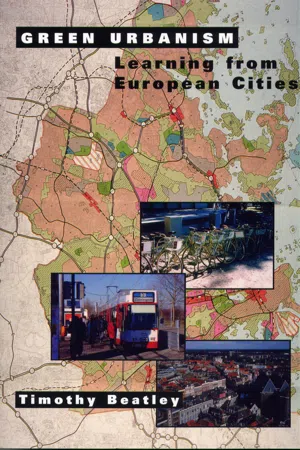• Cities that strive to live within their ecological limits, fundamentally reduce their ecological footprints, and acknowledge their connections with and impacts on other cities and communities and the larger planet.
Green urbanism accepts that public (and private) decisions about how cities grow, the kinds of transportation systems they employ, and the ways they generate and supply energy and food for their populations have tremendous environmental impacts. Green urbanism takes as a primary goal the need to greatly reduce the ecological footprints of cities, to live within the limit of local and regional ecosystems, and to acknowledge that in a host of ways the decisions in one city affect the quality of environment and life in other places, as well as the overall health of the planet. Efforts by cities to reduce carbon dioxide emissions and to reduce the impact of urban consumption patterns, for example, reflect all of these goals.
As the analysis of Herbert Girardet demonstrates, cities such as London consume large amounts of energy and other inputs and produce large amounts of waste. London’s population consumes some 55,000 gallons of fuel and some 6,600 tonnes of food per day, and emits 160,000 tonnes of carbon dioxide per day (see Girardet, undated). Considerable amounts of this food are (increasingly) transported from faraway places: “Early potatoes come from Egypt and Cyprus. Tomatoes, cucumbers and asparagus are imported from Spain, Greece and Holland. Beans are increasingly flown in from Kenya, 4000 miles away” (Girardet, undated, p. 52). Taken together, these inputs and outputs require a land base 125 times the size of London to support its population.
• Cities that are green and that are designed for and function in ways analogous to nature.
Green urbanism requires us to overcome our traditional view of the polarity of cities and nature. Cities, to many, are indeed the very antithesis of nature—places of gray, where one finds concrete and asphalt, buildings and cars, things that could not be natural. Yet, nature does exist in cities, and cities are fundamentally embedded within a larger natural setting.
Ecological architect William McDonough frequently ponders whether towns and cities might function like forests. Indeed, nature is a profoundly helpful paradigm for cities. Cities must strive to be places of nature; they should be sheltering; cleansing of air, water, and spirit; and restorative and replenishing of the planet, rather than fundamentally extractive and damaging.
Moreover, innumerable ways of restoring , replenishing, and nurturing urban ecology exist, such as daylighting streams, planting green rooftops, bringing forests and greenspaces into the very heart of cities, as well as many other creative planning approaches.
• Cities that strive to achieve a circular rather than a linear metabolism, which nurtures and develops positive symbiotic relationships with and between its hinterland (whether that be regional, national, or international).
Nothing in nature is wasted. Wastes become productive inputs for other natural processes. In hundreds of ways, the same principle could apply to the functioning of cities. Wastewater treatment systems can extract biogas to fuel community heating systems; organic household waste can become fertilizer returned to urban populations in the form of food. Industries can feed off each other, with each company’s wastes becoming the productive inputs to production processes of the others.
Green urbanism calls for a circular metabolism for cities, rather than the prevailing linear approach. Green urbanism calls for the balancing of the ecocycles of a city, so that its inputs and outputs are harmonized, complementary, and fundamentally in balance.
• Cities that strive toward local and regional self-sufficiency and take full advantage of and nurture local/regional food production, economy, power production, and many other activities that sustain and support their populations.
Green urbanism demands cities that assume responsibility for the environmental and other impacts of lifestyle and consumption decisions. Historically, it has been easier to ignore the devastating impacts of conventional energy production and production of food, for example, because these impacts have typically been externalized. They happen far away, in distant places, out of sight and mind. Bringing these many functions closer means greater scrutiny and presents more likelihood that responsible actions and choices will result.
What will also result are more healthful lives, for example by avoiding the consumption of chemicals and level of processing needed to transport food hundreds of miles.
• Cities that facilitate (and encourage) more sustainable, healthful lifestyles.
An important measure of a sustainable city, and an important goal of green urbanism, is that such places should make it easier for people to live richer, fuller lives. Most Americans, for instance, have few options besides the automobile. Green urbanism emphasizes giving individuals the ability to walk or ride bicycles if they choose. It gives them the option and the ability to row food, to live with fewer consumer goods, to live without a car if they choose to, and so on. The benefits again extend beyond the environmental. Such conditions empower individuals and families to change in meaningful ways (if they so desire) the directions of their lives and to emphasize the quality of their relationships, rather than the size of their home or their possessions.
• Cities that emphasize a high quality of life and the creation of highly liv - able neighborhoods and communities.
Green urbanism gives centrality to creating (and strengthening) neighborhoods and places where people enjoy being, places that are emotionally uplifting and aesthetically inspirational. It is an agenda that emphasizes the provision of adequate housing and services for all members of society and that seeks to be socially and economically inclusive. It is as much about creating highly livable cities as it is about creating ecological cities (indeed, the goals are mutually reinforcing). Nature in cities is important to livability. Green urbanism presumes that connections to nature are important to personal health and well-being.
